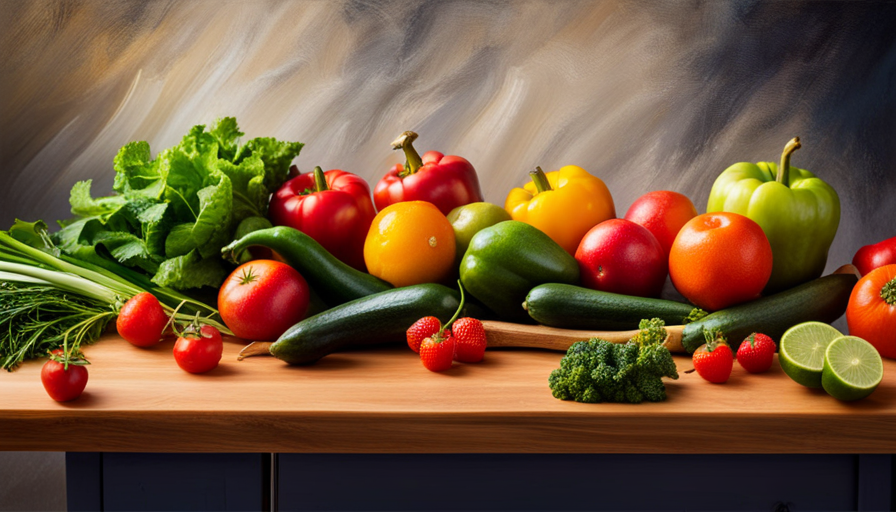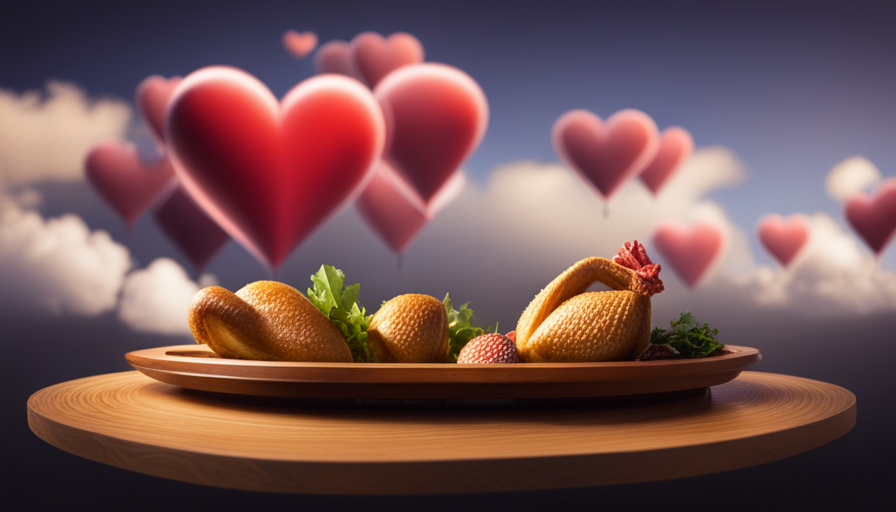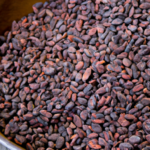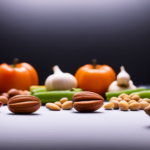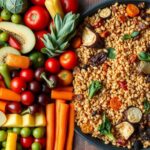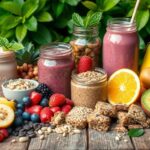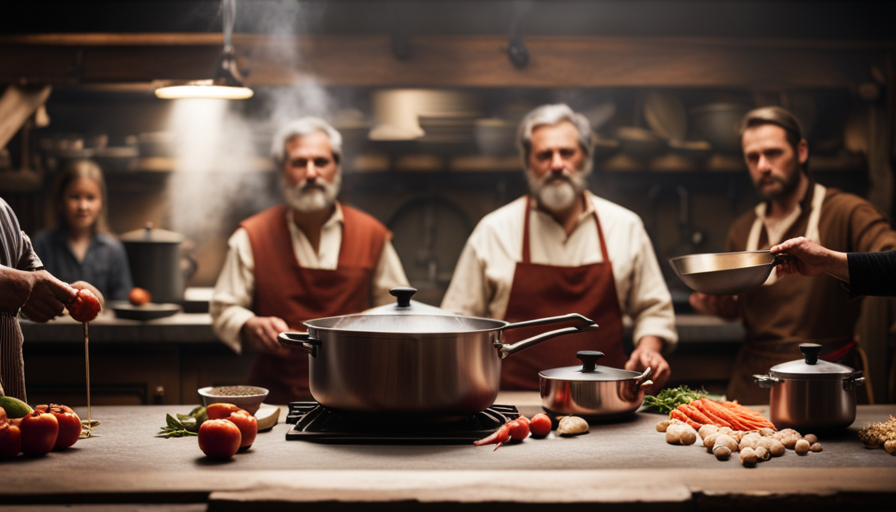In writing, juxtaposition is a powerful tool that allows us to examine contrasting ideas and concepts. Within the realm of nutrition, a key example of this is the comparison between the raw food diet and caloric intake.
While many believe that a raw food diet may restrict calories due to its emphasis on uncooked, plant-based foods, the truth is far more nuanced. Understanding the caloric content of raw foods is essential to comprehending how many calories one can obtain from this dietary approach.
Factors such as food choices, portion sizes, and individual metabolism all play a role in determining caloric intake on a raw food diet.
In this article, we will delve into the intricacies of caloric consumption on a raw food diet, providing valuable insights, meal plans, and recipes to assist you in your journey towards optimal health and well-being.
Key Takeaways
- Raw food diet emphasizes uncooked, plant-based foods that are low in calories but high in vitamins, minerals, and fiber.
- Nuts and seeds, although higher in calories, provide essential nutrients and healthy fats that are important for overall health.
- Grains and legumes, while varying in calorie content, are a good source of complex carbohydrates and protein, supporting a strong immune system.
- Oils and fats, although high in calories, add flavor and provide essential fatty acids and fat-soluble vitamins to raw food dishes.
Understanding the Raw Food Diet
Get ready to discover how many calories you can enjoy while following the raw food diet! The raw food diet is a dietary approach that emphasizes the consumption of unprocessed and uncooked foods. It includes fruits, vegetables, nuts, seeds, and sprouted grains. Proponents of this diet believe that consuming raw foods helps preserve the nutrients and enzymes, which can be lost during cooking.
However, it’s important to consider food safety when following this diet. Raw foods can be a breeding ground for harmful bacteria, such as Salmonella and E. coli. Therefore, it’s crucial to properly wash and handle raw foods to reduce the risk of foodborne illnesses.
Additionally, some potential health risks associated with the raw food diet include nutrient deficiencies, especially in vitamin B12, iron, and calcium. It’s important to ensure that you’re meeting your nutritional needs while following this diet.
Exploring the caloric content of raw foods will provide further insight into the potential benefits and challenges of following the raw food diet.
Exploring the Caloric Content of Raw Foods
In exploring the caloric content of raw foods, it’s important to consider the different categories of foods and their respective calorie counts.
Fruits and vegetables, for example, are generally low in calories but high in vitamins, minerals, and fiber.
Nuts and seeds, on the other hand, are higher in calories due to their fat content, but they also provide important nutrients and healthy fats.
Grains and legumes can vary in calorie content depending on the specific type, but they’re often a good source of complex carbohydrates and protein.
Oils and fats, while high in calories, can provide essential fatty acids and fat-soluble vitamins.
Fruits and Vegetables
You’ll be amazed at how many calories you can save by incorporating a variety of colorful fruits and vegetables into your raw food diet; for example, a medium-sized apple contains only about 95 calories. Fruits and vegetables are not only low in calories, but they also provide a wide range of essential nutrients and antioxidants. Understanding the nutritional benefits of different fruits and vegetables is key to incorporating variety into your raw food diet. To help you visualize the calorie content of some common fruits and vegetables, here is a table showcasing their calorie content per serving:
| Fruit/Vegetable | Calories per Serving |
|---|---|
| Apple | 95 |
| Banana | 105 |
| Carrot | 41 |
| Spinach | 23 |
| Tomato | 22 |
By including a variety of these low-calorie, nutrient-rich options in your raw food diet, you can enjoy a filling and satisfying meal while still keeping your calorie intake in check. Now, let’s move on to the next section about nuts and seeds.
Nuts and Seeds
Incorporating a variety of nuts and seeds into your daily meals will provide you with essential nutrients and add a delicious crunch to your dishes. Nuts and seeds are not only a great source of healthy fats, but they also provide a wide range of vitamins, minerals, and antioxidants.
For example, almonds are rich in vitamin E, which promotes healthy skin and protects against oxidative damage. Chia seeds are packed with fiber and omega-3 fatty acids, which support heart health and aid in digestion. However, it’s important to practice portion control when consuming nuts and seeds, as they’re high in calories. A small handful or a tablespoon is usually a good serving size.
By incorporating nuts and seeds into your diet, you can enjoy their nutritional benefits while maintaining a balanced intake.
Moving on to the next section, let’s explore the nutritional benefits of grains and legumes.
Grains and Legumes
Grains and legumes are like the foundation of a hearty and satisfying meal, providing nourishment and a comforting texture that’ll leave you feeling satisfied. Not only are they delicious, but they also offer a wide range of nutritional benefits.
Here are three reasons why grains and legumes are essential for a healthy diet:
-
High in fiber: Grains and legumes are rich in dietary fiber, which helps regulate digestion and keeps you feeling full for longer. This can aid in weight management and prevent overeating.
-
Good source of protein: Grains and legumes are an excellent plant-based protein option, making them ideal for vegetarians and vegans. Protein’s essential for building and repairing tissues and plays a vital role in various bodily functions.
-
Packed with vitamins and minerals: Grains and legumes are loaded with essential vitamins and minerals, including B vitamins, iron, magnesium, and zinc. These nutrients support overall health and contribute to a strong immune system.
Moving on to oils and fats…
Oils and Fats
Indulge in the rich and creamy goodness of oils and fats, adding a delectable touch to your meals that’ll leave your taste buds dancing with delight. Oils and fats are an essential part of the raw food diet, providing a concentrated source of energy and essential fatty acids.
When it comes to cooking methods, it’s important to choose options that preserve the nutritional value of these oils and fats. Cold-pressed oils, such as olive oil and coconut oil, are popular choices due to their minimal processing and high nutrient content. These oils can be used in dressings, dips, and marinades to enhance the flavor of your raw food dishes.
Additionally, incorporating raw nuts, seeds, and avocados into your meals can provide healthy fats and add a creamy texture. These cooking methods and ingredient choices contribute to a well-rounded raw food diet.
Moving forward, let’s explore the factors that affect caloric intake on a raw food diet.
Factors Affecting Caloric Intake on a Raw Food Diet
Portion sizes and serving suggestions play a crucial role in determining caloric intake on a raw food diet. By being mindful of the quantity of food consumed, one can better manage their calorie intake and ensure they’re meeting their nutritional needs.
Additionally, the method of food preparation can also impact caloric content. For example, raw food that’s blended or juiced may be more calorie-dense compared to whole foods.
Lastly, the combination of ingredients in a raw food diet can affect caloric intake. Some ingredients may be more energy-dense than others, so it’s important to be conscious of the overall balance of ingredients to maintain a healthy caloric balance.
Portion Sizes and Serving Suggestions
If you’re looking for a satisfying and nutritious way to fuel your body, consider incorporating the raw food diet into your lifestyle. One important aspect of this diet is portion control, which plays a vital role in maintaining nutritional balance.
While it’s true that raw foods are generally lower in calories than cooked foods, it’s still important to pay attention to portion sizes to ensure you’re getting the right amount of calories for your body’s needs. A balanced raw food meal should include a variety of fruits, vegetables, nuts, and seeds, in appropriate quantities.
For example, a typical serving of fruits or vegetables is about one cup, while a serving of nuts or seeds is around a quarter cup. By practicing portion control and maintaining nutritional balance, you can enjoy the benefits of the raw food diet.
Moving forward, let’s explore the various food preparation methods that can be used on this diet.
Food Preparation Methods
Get ready to explore the exciting world of food preparation methods on the raw food diet. When it comes to preparing raw food, it’s essential to prioritize food safety.
Here are three important food safety practices to keep in mind:
-
Washing: Thoroughly wash all fruits and vegetables before consuming them raw. This helps remove any dirt, bacteria, or pesticides that may be present.
-
Soaking and Sprouting: Soaking nuts, seeds, and grains before consuming them can help improve their digestibility and increase their nutritional benefits. Sprouting, on the other hand, can enhance the availability of nutrients and enzymes in these foods.
-
Dehydrating: Dehydrating fruits, vegetables, and even nuts can help preserve their nutrients and flavors. It’s important to dehydrate them at low temperatures to maintain their raw state.
By following these food safety practices, you can ensure that your raw food preparations are safe and nutritious. Now let’s explore the next section on the combination of ingredients.
Combination of Ingredients
Mixing ingredients on the raw food diet is like creating a symphony of flavors that dance on your taste buds, taking them on a wild and exhilarating ride. The combination of flavors in raw food recipes is not only delicious but also offers a wide range of nutritional benefits.
By combining different fruits, vegetables, nuts, and seeds, you can create a variety of vibrant and satisfying meals. For example, blending bananas with spinach and almond milk creates a creamy and nutritious green smoothie packed with vitamins and minerals. Adding dates, cacao powder, and avocado to a blender results in a rich and decadent chocolate mousse that is both healthy and indulgent.
These combinations not only provide a burst of flavor but also ensure you’re getting a diverse array of nutrients.
Moving forward to tracking and monitoring caloric intake, it’s important to keep a close eye on the number of calories consumed in order to maintain a balanced diet.
Tracking and Monitoring Caloric Intake
Monitoring my caloric intake is essential when following the raw food diet. There are various tracking methods available to help me keep a record of the calories I consume. One option is to use a food diary, where I jot down everything I eat and its corresponding calorie content. This allows me to have a clear picture of my daily caloric intake and make adjustments if needed.
Another method is to use a smartphone app or website that provides nutritional information for different foods. These tools often have a vast database of raw food options, making it easier for me to track my calories accurately.
There are several benefits to monitoring my caloric intake on the raw food diet. Firstly, it helps me ensure I’m getting enough nutrients and energy to support my body’s needs. By tracking my calories, I can identify any deficiencies and make adjustments to my diet accordingly. Additionally, monitoring my caloric intake allows me to maintain a healthy weight and avoid overeating. It provides me with a sense of control and accountability, helping me stay on track with my health goals.
Transitioning to the subsequent section about sample meal plans and recipes, I can use the information gathered from tracking and monitoring my caloric intake to create balanced and nutritious meals.
Sample Meal Plans and Recipes
When it comes to following a raw food diet, it’s essential to have a variety of meal options. This helps maintain a balanced and nutritious intake.
For breakfast, I like to start my day with a refreshing smoothie. I make it with fruits, leafy greens, and a handful of nuts or seeds for added protein and healthy fats.
For lunch and dinner, I enjoy creating vibrant salads. I mix raw vegetables, sprouts, and a homemade dressing made with lemon juice and olive oil.
As for snacks and desserts, I often opt for raw nuts, seeds, and fresh fruits. Sometimes, I whip up a delicious raw chocolate avocado mousse for a guilt-free treat.
Breakfast Ideas
Looking for a simple way to kickstart your day with a nourishing meal on the raw food diet? Why not try some deliciously energizing breakfast ideas? Breakfast is an important meal that provides the necessary fuel to start your day off right. Incorporating raw foods into your breakfast can provide numerous nutritional benefits. Here are some breakfast recipes that are not only delicious but also packed with nutrients:
| Breakfast Ideas | Nutritional Benefits |
|---|---|
| Green Smoothie Bowl | High in vitamins and minerals, provides hydration |
| Chia Pudding | Rich in omega-3 fatty acids, excellent source of fiber |
| Fresh Fruit Salad | Loaded with antioxidants, boosts immune system |
| Raw Granola | Contains healthy fats and proteins, provides energy |
| Avocado Toast | High in healthy fats, promotes heart health |
These breakfast ideas will leave you feeling satisfied and energized. Now, let’s move on to the next section and explore some lunch and dinner options.
Lunch and Dinner Options
Let’s dive into some delectable lunch and dinner options that’ll keep you satisfied and nourished on the raw food journey.
When it comes to portion control on a raw food diet, it’s important to listen to your body’s hunger and fullness cues. Raw food meals can be just as filling and satisfying as cooked meals if you choose the right ingredients and balance your plate with a variety of nutrients.
Incorporating a mix of fruits, vegetables, nuts, and seeds can provide the necessary nutrients for your body’s needs. Additionally, raw foods are rich in enzymes that aid in nutrient absorption, ensuring that you get the most out of your meal.
As we move into the next section about snack and dessert recipes, you’ll find even more delicious options to satisfy your cravings.
Snack and Dessert Recipes
Indulge in these mouthwatering snack and dessert recipes that’ll satisfy your cravings and add a sweet touch to your raw food journey.
When following a raw food diet, it’s important to have a variety of snack options to keep you energized throughout the day. Some great snack ideas include raw nuts, seeds, and dried fruits. These provide a healthy dose of fats, protein, and carbohydrates to keep you feeling satisfied.
For a sweet treat, try making raw dessert recipes like raw chocolate avocado mousse or raw coconut bliss balls. These desserts are made with nutrient-dense ingredients like avocado, cacao powder, and dates, providing a burst of flavor and essential nutrients.
Now that we’ve covered snack and dessert recipes, let’s move on to meeting our nutritional needs on a raw food diet.
Meeting Nutritional Needs on a Raw Food Diet
Eating a raw food diet can be a challenge when it comes to meeting your nutritional needs, but it’s possible to get enough calories from a variety of plant-based sources.
Meeting nutritional needs on a raw food diet requires careful planning and attention. One important aspect is tracking your caloric intake. You can do this by keeping a food diary or using a smartphone app. By tracking your caloric intake, you can ensure that you’re getting enough calories to meet your energy needs.
Some common plant-based sources of calories on a raw food diet include fruits, vegetables, nuts, seeds, and sprouted grains. These foods are not only rich in calories but also provide essential nutrients such as vitamins, minerals, and antioxidants. It’s important to include a variety of these foods in your diet to ensure that you’re getting all the nutrients your body needs.
Transitioning to the next section about weight management on a raw food diet, it’s important to note that maintaining a healthy weight is possible on this diet.
Weight Management on a Raw Food Diet
To successfully manage your weight on a raw food diet, it’s crucial to find the perfect balance of nourishing whole foods and regular physical activity. As the saying goes, "You’re what you eat." When it comes to weight loss, the raw food diet can be effective due to its emphasis on nutrient-dense foods and low-calorie options. However, it’s important to be mindful of potential nutrient deficiencies that can occur with this diet.
To ensure adequate nutrient intake while on a raw food diet, it’s essential to focus on incorporating a variety of fruits, vegetables, nuts, seeds, and sprouted grains. These foods provide essential vitamins, minerals, and fiber while being low in calories. Additionally, including sources of plant-based protein, such as legumes and quinoa, can help maintain muscle mass during weight loss.
While weight loss can be achieved on a raw food diet, it’s important to listen to your body’s hunger and fullness cues. This means being mindful of portion sizes and eating when you’re truly hungry rather than relying on external cues. By paying attention to your body’s signals, you can ensure that you’re nourishing yourself adequately while still reaching your weight loss goals.
Listening to Your Body’s Hunger and Fullness Cues
Transition: Now that we have discussed weight management on a raw food diet, let’s delve into the importance of listening to your body’s hunger and fullness cues.
Current Subtopic: Listening to Your Body’s Hunger and Fullness Cues
When following a raw food diet, it is crucial to be in tune with your body’s signals of hunger and fullness. This practice is often referred to as intuitive eating or mindful eating. By paying attention to these cues, you can ensure that you are consuming the appropriate amount of calories for your body’s needs.
To help you better understand your body’s cues, it can be helpful to create a hunger and fullness scale. This can be done by using a simple 2 column and 5-row table, where one column represents levels of hunger (ranging from starving to comfortably full) and the other column represents levels of fullness (ranging from empty to overly stuffed). By regularly assessing your hunger and fullness levels and documenting them in the table, you can gain insights into your eating patterns and make adjustments as needed.
By practicing intuitive eating and mindful eating, you can establish a healthier relationship with food and prevent overeating or undereating. This approach allows you to honor your body’s true needs and experience a more satisfying and nourishing raw food diet.
Transition: Now that we have explored the importance of listening to our body’s hunger and fullness cues, let’s address common myths and misconceptions about raw food diets.
Common Myths and Misconceptions about Raw Food Diets
Get ready to debunk some common myths and misconceptions about the raw food lifestyle! Contrary to popular belief, a raw food diet can provide all the essential nutrients your body needs.
Here are some key benefits of a raw food diet:
-
Increased nutrient intake: Raw fruits, vegetables, nuts, and seeds are packed with vitamins, minerals, and enzymes that can enhance your overall health and well-being.
-
Improved digestion: Raw foods contain natural enzymes that aid in the digestion process. These enzymes can help break down food more efficiently, leading to better nutrient absorption and reduced digestive issues.
-
Weight management: Many people find that a raw food diet helps them maintain a healthy weight. Raw foods are typically lower in calories and higher in fiber, which can promote feelings of fullness and reduce overeating.
-
Enhanced energy levels: Raw foods are rich in nutrients and are easier for the body to digest, which can result in increased energy levels throughout the day.
While a raw food diet can offer numerous benefits, it’s important to seek professional guidance and support to ensure you’re meeting your nutritional needs. Transitioning to a raw food lifestyle may require adjustments and personalized advice from a healthcare professional or registered dietitian.
Seeking Professional Guidance and Support
Seeking professional guidance and support is essential when adopting a raw food lifestyle, as it ensures that you receive personalized advice and assistance in meeting your nutritional needs. While the raw food diet can offer numerous health benefits, it’s important to approach it with caution and make informed choices about your nutrition.
Consulting with a registered dietitian or nutritionist who specializes in raw food diets can provide you with the necessary guidance to ensure a well-rounded and balanced approach to your eating habits. These professionals can help you create a meal plan that meets your specific calorie and nutrient requirements. They can also offer advice on food safety, as consuming raw foods carries a higher risk of foodborne illnesses.
By seeking professional advice, you can address any concerns or questions you may have and receive evidence-based recommendations tailored to your individual needs.
In addition to professional guidance, online communities can be a valuable source of support when following a raw food lifestyle. Connecting with like-minded individuals who are also on a raw food diet can provide a sense of community and encouragement. Online forums, social media groups, and blogs dedicated to raw food diets allow you to share your experiences, ask questions, and receive support from others who understand the challenges and benefits of this way of eating.
Seeking professional advice and joining online communities can greatly enhance your experience with a raw food lifestyle. These resources can provide you with the personalized guidance and support you need to ensure a healthy and successful journey.
Frequently Asked Questions
Can I still meet my nutritional needs on a raw food diet?
Yes, it’s possible to meet your nutritional needs on a raw food diet. For example, Sarah, a 35-year-old woman, follows a raw food diet and has successfully met her nutritional needs. She ensures she includes a variety of fruits, vegetables, nuts, and seeds in her meals to get essential vitamins, minerals, and antioxidants.
However, it’s important to plan your meals carefully to ensure you’re getting enough protein, calcium, and vitamin B12, which can be lacking in a raw food diet.
How can I track and monitor my caloric intake on a raw food diet?
To track and monitor my caloric intake on a raw food diet, I can use tracking software or calorie counting apps. These tools allow me to input the foods I consume and calculate their caloric values. By regularly logging my meals and snacks, I can ensure that I’m meeting my specific caloric needs. This helps me stay on track with my nutrition goals and maintain a balanced raw food diet.
What are some common myths and misconceptions about raw food diets?
Some common myths and misconceptions about raw food diets include the belief that they lack essential nutrients, are difficult to follow, and are only for extreme health enthusiasts. However, research shows that raw food diets can provide numerous benefits such as increased energy levels, improved digestion, and better overall health.
Additionally, there are plenty of delicious and nutritious raw food diet recipes available that can make the transition to this lifestyle easier and more enjoyable.
How can I manage my weight on a raw food diet?
To manage my weight on a raw food diet, I focus on raw food diet weight loss strategies and meal planning.
Firstly, I ensure my meals are balanced and include a variety of fruits, vegetables, nuts, and seeds. This helps me meet my nutritional needs and maintain a healthy weight.
Additionally, I pay attention to portion sizes and listen to my body’s hunger and fullness cues. Regular physical activity is also important for weight management on a raw food diet.
When should I seek professional guidance and support while following a raw food diet?
When embarking on a raw food diet, it’s crucial to seek professional guidance. This will ensure proper nutrition and help you avoid potential health risks. Nutritionists or dietitians can provide personalized advice, monitor your progress, and address any concerns or deficiencies. Their expertise will help you navigate the challenges of a raw food diet and ensure you’re meeting your nutritional needs. Trusting in their guidance will provide you with the support necessary to successfully follow a raw food diet while prioritizing your health.
What Are the Recommended Caloric Intake for a Raw Food Diet?
The recommended raw food diet calories typically range from 1,200 to 1,800 per day, depending on individual factors such as age, gender, and activity level. It’s important to focus on consuming nutrient-dense foods that provide essential vitamins, minerals, and antioxidants to support overall health and well-being.
Conclusion
As I reflect on my journey into the world of raw food diets, I’m amazed by the power of nature’s bounty to nourish and sustain us. The raw food diet has shown me that calories aren’t the sole measure of a healthy lifestyle.
Symbolically, this diet represents a return to our roots, reconnecting with the earth and embracing the simplicity of whole, unprocessed foods. By listening to our bodies and honoring its hunger and fullness cues, we can achieve balance and harmony.
With the right guidance and support, the raw food diet can be a transformative experience.

